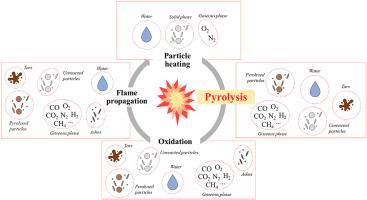Making hybrid mixture explosions a common case |
| |
| Affiliation: | 1. KU Leuven, Department of Mechanical Engineering, Group T Leuven Campus, A. Vesaliusstraat 13, B-3000, Leuven, Belgium;2. KU Leuven, Department of Materials Engineering, Group T Leuven Campus, A. Vesaliusstraat 13, B-3000, Leuven, Belgium;3. KU Leuven, Department of Chemical Engineering, Celestijnenlaan 200F, B-3001, Leuven, Belgium;4. KU Leuven, Department of Mechanical Engineering, Celestijnenlaan 300A, B-3001, Leuven, Belgium;5. Adinex NV, Brouwerijstraat 11, B-2200, Herentals, Belgium;6. North-West University, Material Science, Innovation and Modelling (MaSIM), Private Bag X2046, 2745, Mmabatho, South Africa;1. Institute of Public Safety Research, Department of Engineering Physics, Tsinghua University, China;2. Beijing Key Laboratory of Comprehensive Emergency Response Science, China;1. Swiss Process Safety Consulting GmbH, Schönenbuchstrasse 36, CH-4123, Allschwil, Switzerland;2. Covestro Deutschland AG, Kaiser-Wilhelm-Allee 101–103, D-51373, Leverkusen, Germany;1. College of Chemistry and Chemical Engineering, China University of Petroleum (East China), Qingdao, 266580, China;2. Saifeite Engineering Group Co. Ltd., Qingdao, 266061, China;3. Department of Safety, Health, And Environmental Engineering, National Yunlin University of Science and Technology, Yunlin, 64002, Taiwan, ROC;1. CAIMI Centro de Aplicaciones Informáticas y Modelado en Ingeniería, Universidad Tecnológica Nacional, Facultad Regional Rosario, Zeballos, 1346, S2000BQA, Rosario, Argentina;2. CONICET Consejo Nacional de Investigaciones Científicas y Técnicas, Blvd. 27 de Febrero 210 Bis, S2000EZP, Rosario, Argentina |
| |
| Abstract: | 
Explosions of gas-dust hybrid mixtures have long been considered as particular cases encountered in specific industrial contexts. However, it should be reminded that during the explosion of an organic powder, the presence of a hybrid mixture composed of the dust itself and its pyrolysis gases is compulsory. On these premises, an experimental study to determine the role of cellulose pyrolysis products (gaseous, condensable and solid) on the global phenomenon is presented. Hybrid mixture explosion tests were exploited to carry out the investigation. The G-G furnace and the 20 L sphere were employed. Several experimental strategies were chosen to demonstrate the impact of pyrolysis reaction on the explosion of organic powders: i) the fuel equivalence ratio of the reactive mixture (case 1), or ii) the mass of reactants (case 2) were respectively kept constant, iii) the effects of water vapor, char and tar were tested. They were next compared to identify the most suitable one. The two first experimental approaches lead to significantly different results: only case 2 keeps the maximum explosion pressure almost constant, but maximum rate of pressure rises and deflagration index greatly decrease when the pyrolysis gases concentration decreases, which highlights the importance of the pyrolysis reaction on the explosion kinetics. It should also be stressed that the maximum explosion severity is not obtained for the pure gases but when a small dust content is added. The same evolution is observed when a small amount of char is introduced to pyrolysis gases, which underlines the influence of the radiative transfer. Adding small amounts of tar to cellulose tends to increase its explosion severity. However, this impact is less than that generated by the addition of pyrolysis gases. |
| |
| Keywords: | Dust explosion Pyrolysis Hybrid mixture Cellulose |
| 本文献已被 ScienceDirect 等数据库收录! |
|

